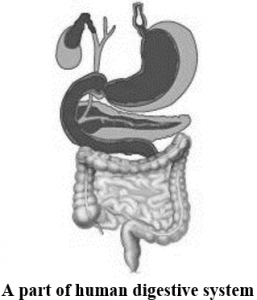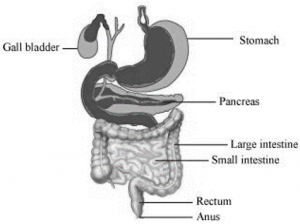NCERT TEXT BOOK EXERCISES
Q1. Fill in the blanks:
(a) The main steps of nutrition in humans are __________, __________, ___________, __________ and__________
(b) The largest gland in the human body is __________.
(c) The stomach releases hydrochloric acid and ________ juices which act on food.
(d) The inner wall of the small intestine has many finger-like outgrowths called __________.
(e) Amoeba digests its food in the ______.
Ans. (a) The main steps of nutrition in humans are ingestion, digestion, absorption, assimilation and egestion.
(b) The largest gland in the human body is liver.
(c) The stomach releases hydrochloric acid and digestive juices which act on food.
(d) The inner wall of the small intestine has many finger-like outgrowths called villi.
(e) Amoeba digests its food in the food vacuole.
Q2. Mark ‘T’ if the statement is true and ‘F’ if it is false:
(a) Digestion of starch starts in the stomach. (T/F)
(b) The tongue helps in mixing food with saliva. (T/F)
(c) The gall bladder temporarily stores bile. (T/F)
(d) The ruminants bring back swallowed grass into their mouth and chew it for some time. (T/F)
Ans. (a) Digestion of starch starts in the stomach. (F)
(b) The tongue helps in mixing food with saliva. (T)
(c) The gall bladder temporarily stores bile. (T)
(d) The ruminants bring back swallowed grass into their mouth and chew it for some time. (T)
Q3 Tick (✓) mark the correct answer in each of the following:
(a) Fat is completely digested in the
(i) stomach
(ii) mouth
(iii) small intestine
(iv) large intestine
(b) Water from the undigested food is absorbed mainly in the
(i) stomach
(ii) food pipe
(iii) small intestine
(iv) large intestine
Ans. (a) Fat is completely digested in the
(i) stomach
(ii) mouth
(iii) small intestine ✓
(iv) large intestine
(b) Water from the undigested food is absorbed mainly in the
(i) stomach
(ii) food pipe
(iii) small intestine
(iv) large intestine ✓
Q4.Match the items of Column I with those given in Column II:
| Column I | Column II |
| Food components | Product(s) of digestion |
| Carbohydrates | Fatty acids and glycerol |
| Proteins | Sugar |
| Fats | Amino acids |
Ans.
| Column I | Column II |
| Food components | Product(s) of digestion |
| Carbohydrates | Sugar |
| Proteins | Amino acids |
| Fats | Fatty acids and glycerol |
Q5. What are villi? What is their location and function?
Ans. Villi are tiny finger-like projections originating from the walls of the small intestine. They increase the surface area for absorption of the digested food. The blood vessels present inside the villi can absorb the nutrients from the digested food. 
Q6. Where is the bile produced? Which component of the food does it help to digest?
Ans. Liver secretes the bile juice which is stored in the gall bladder. Bile plays an important role in the digestion of fats.
Q7. Name the type of carbohydrate that can be digested by ruminants but not by humans. Give the reason also.
Ans. Cellulose is a type of carbohydrate that can be digested by ruminants and not by humans. Ruminants have a large sac-like structure between small and large intestine where the food containing cellulose is digested by the action of certain bacteria. On the other hand, humans cannot digest cellulose, as the cellulose digesting enzymes are absent in them.
Q8. Why do we get instant energy from glucose?
Ans. Glucose is a simple sugar. Carbohydrates, when consumed, have to be digested into glucose. As glucose can be easily absorbed in blood, it provides energy to the body. Hence, when glucose is directly taken, it does not have to be digested and thus acts as an instant source of energy.
Q9. Which part of the digestive canal is involved in:
(i) absorption of food ____.
(ii) chewing of food ____.
(iii) killing of bacteria ____.
(iv) complete digestion of food ____.
(v) formation of faeces ____.
Ans. (i) absorption of food small intestine.
(ii) chewing of food buccal cavity.
(iii) killing of bacteria stomach.
(iv) complete digestion of food small intestine.
(v) formation of faeces large intestine.
Q10. Write one similarity and one difference between the nutrition in Amoeba and human beings.
Ans. Similarity between nutrition in Amoeba and human beings: Both Amoeba and humans require energy for the growth and maintenance of their bodies. This energy is derived from the food that they eat. The food that they consume is always in a complex form and is therefore broken down into simpler forms by the process of digestion. Hence, both these organisms are heterotrophs.
Differences between nutrition in Amoeba and human beings:
| Digestion in Humans | Digestion in Amoeba | ||
| (i) | Humans have a mouth and a complex digestive system. | (i) | Mouth and digestive system are absent in Amoeba. |
| (ii) | Digestive juices are secreted in the buccal cavity, stomach, and small intestine. | (ii) | Digestive juices are secreted in the food vacuole. |
| (iii) | Digestion of carbohydrates, proteins, and fats starts in separate regions. | (iii) | All the food components are digested in the food vacuole. |
Q11. Match the items of Column I with suitable items in Column II
| – | Column I | – | Column II |
| (a) | Salivary gland | (i) | Bile juice secretion |
| (b) | Stomach | (ii) | Storage of undigested food |
| (c) | Liver | (iii) | Saliva secretion |
| (d) | Rectum | (iv) | Acid release |
| (e) | Small intestine | (v) | Digestion is completed |
| (f) | Large intestine | (vi) | Absorption of water |
| – | – | (vii) | Release of faeces |
Ans.
| – | Column I | – | Column II |
| (a) | Salivary gland | (iii) | Saliva secretion |
| (b) | Stomach | (iv) | Acid release |
| (c) | Liver | (i) | Bile juice secretion |
| (d) | Rectum | (ii) | Storage of undigested food |
| (e) | Small intestine | (v) | Digestion is completed |
| (f) | Large intestine | (vi) | Absorption of water |
Q12. Label the following figure of the digestive system.  Ans.
Ans. 
Q13. Can we survive only on raw, leafy vegetables/grass? Discuss.
Ans. No. Humans cannot survive only on raw, leafy vegetables, or grass. It is because the grass is rich in cellulose, which is a type of carbohydrate that humans are not able to digest due to the absence of cellulose-digesting enzymes.








